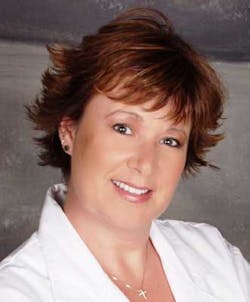The importance of the dental hygiene appointment sequence
The order in which things are done is very important. Take for instance when you go to the hair stylist, your hair will be washed first. If the hair is cut when it’s dry you get a choppy, jagged haircut. Things are done in a certain order for a reason. The same is true for a dental hygiene appointment.
First, gather all the diagnostics. Without doing this first, it’s like driving a car blindfolded to an unknown location without a map. This critical step includes updating the medical history, periodontal risk assessment, oral cancer screening (doctor will follow up during exam) and blood pressure. Taking appropriate radiographs (FMX, horizontal/vertical BW’s) is best taken at the beginning of the appointment as the images are not only used to detect decay and pathology, but also to evaluate bone levels and supporting tooth structures. Lastly, a six-point periodontal charting documenting pocket depths, recession, bleeding, and furcation involvement is recorded.
The information gathered during this portion of the dental hygiene visit determines the difference between a prophy and periodontal therapy, in other words, "you have to probe first" before you pick up a scaler!
It’s time for treatment. Have the patient do a 30 second pre-procedural rinse and then proceed with Ultrasonics throughout the entire mouth (including the tongue) followed by hand scaling. Next is polishing, unless "therapeutic" polishing is necessary for desensitization. If that’s the case then polishing would come first. Patients may be more comfortable when polishing first with a desensitizing prophy paste (ProClude, Enamel Pro, Nova Min, etc). The later part of the clinical portion of the appointment includes flossing, irrigating, applying isolated locally-applied antimicrobials if necessary, post op instructions, and oral hygiene instruction.
Doctor examination. Utilizing caries detection technology (Diagnodent, SoproLife), Dental Patient Education (CAESY) and the intraoral camera will help to easily communicate restorative needs to the patient and increase patient compliance. Finish up with personalized oral hygiene instruction and establish a continuing recare frequency. Prepare oral cancer screening technology (chemiluminescent light source is most effective for the first ten minutes) and notify the doctor for an exam. While waiting for the doctor, schedule the patient’s next appointment and prepare a "take home” bag of oral hygiene supplies. Lastly, enter all treatment and documenting all details into the computer (or write up your chart).
The order in which you do things really does matter! Taking a methodical approach will standardize treatment and ensure excellent care for your patient. For a copy of a Dental Hygiene Appointment Sequence Protocol, contact me at [email protected].

